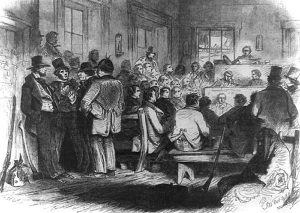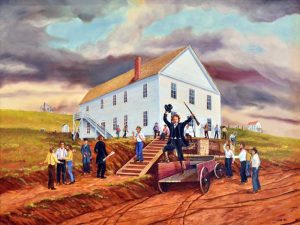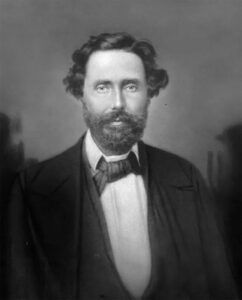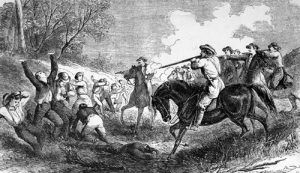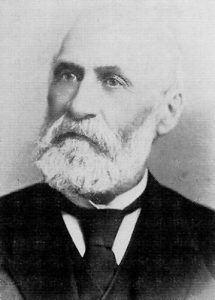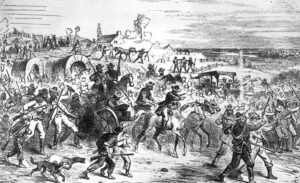Beginning of the Political Period, 1857. The Missourians had given up hope of conquering Kansas by force. After the close of the period of violence, the contest became almost entirely a political struggle between the pro-slavery and the Free-State settlers, each side trying to win Kansas by securing control of its government. The next few years were filled with conventions, elections, and political schemes.
Governor Geary Leaves the Territory. The second territorial Legislature met at Lecompton in the opening days of 1857. Because of Governor John Geary’s efforts to be just to both sides, the Legislature did everything possible to annoy and harass him. The Free-State men rallied to his support, but conditions soon became so intolerable that one night in March, after having been in office about six months, he made a hasty escape from Kansas. Governor Geary had found Kansas in a deplorable condition and left it not significantly improved, but he had attempted to do justice to all. His place was taken by Governor Robert Walker, who arrived in May.
A pro-slavery Constitution Prepared, 1857. Up to this time, the only attempt to get Kansas admitted as a state was the effort of the Free-State men under the Topeka Constitution. Still, the pro-slavery people had long been planning to draw up a constitution under which they might secure the admission of Kansas as a slave state. The Territorial Legislature provided for a constitutional convention, which met at Lecompton in September 1857 and prepared what was called the Lecompton Constitution.
The First Free-State Territorial Legislature. Two important events were to take place in the fall of 1857: the election of a new Territorial Legislature and the vote on the Lecompton Constitution. When election day came, United States troops were stationed in the different precincts to prevent illegal voting and invasions from Missouri. Under Governor Walker’s promise of a fair election, both parties voted for the first time since the fraudulent election in the spring of 1855. The result was a Free-State victory and the first time Kansas was to have a Free-State Legislature. This result was not achieved without many protests and threats from the pro-slavery people, who now became afraid to submit their Lecompton Constitution to a vote, for it was clear that the Free-State people were mainly in the majority and would defeat it. Fear to Submit the Lecompton Constitution. After several meetings and debates among themselves, the pro-slavery people decided to get around this difficulty by not submitting the Constitution at all but by offering instead these two statements to choose between: “The Constitution with slavery” or “The Constitution without slavery.”
Each Side Holds an Election. This gave the Free-State people no chance to vote against the Constitution as a whole, and their anger was aroused. The election was held in December 1857. The Free-State men refused to vote. After several meetings and a special session of their new Free-State Legislature, the Free-State people appointed a day in January 1858 for an election to decide for or against the Constitution. This time the pro-slavery party refused to vote. Thus each side held an election and carried its point by a significant majority.
End of the Lecompton Constitution. No attention was paid to the defeat of the Constitution at the hands of the Free-State people, and it was sent to Congress. After a lengthy discussion, Congress attached several conditions to the Constitution and sent it back to Kansas to be voted on by all the people. Of the 13,000 votes cast at this election, which was held on August 2, 1858, more than 11,000 were against it. This ended the second attempt to get Kansas admitted as a state.
The Leavenworth Constitution, 1858. While the Lecompton Constitution was pending in Congress, the Free-State people concluded that it was time for them to try their hands at constitution-making again. During the winter and spring of 1858, they produced the Leavenworth Constitution, but it was not favorably received by the people of Kansas and was never voted on by either house of Congress.
Trouble in Southeastern Kansas. These events of Territorial history occurred within a small area. With Lawrence as a center, a circle with a radius of thirty miles would include virtually all of them. Another part of Kansas, the southeastern, including what is now Miami, Linn, and Bourbon Counties, came into prominence at this time and showed that the period of bloodshed was not yet past. The southeastern part of the Territory had been settled mainly by pro-slavery people, but gradually the Northerners began to come in. The pro-slavery people frequently made raids on them, the Free-State settlers retaliated, and southern Kansas was soon amid guerrilla warfare. The Free-State people engaged in this warfare came to be known as Jayhawkers. Their leader was a man named James Montgomery.
The Marais des Cygnes Massacre. These conditions continued until the spring of 1858. While the Lecompton and Leavenworth Constitutions were being considered in the Territory, there occurred in Linn County the Marais des Cygnes Massacre, the most shocking and bloody event of the whole Territorial period. A Southerner named Charles A. Hamilton made up a list of Free-State men he planned to seize and execute. On May 19, almost two years after the Pottawatomi Massacre by John Brown, Hamilton, with a gang of Missourians, captured eleven Free-State men, marched them to a nearby gulch, lined them up, and fired a volley. Five men were killed, five were wounded, and one remained unharmed. This terrible deed created great excitement, and an unsuccessful attempt was made to capture Hamilton and his men.
Order Restored. Steps were taken to bring about a more settled condition in southeastern Kansas. Though several other outrages took place, none were so brutal as the Marais des Cygnes massacre, and order was gradually restored.
Pro-slavery and Free-State Names Dropped. During the trouble over the Lecompton Constitution in the closing days of 1857, Governor James Walker was compelled to resign. In the autumn of 1858, Governor James Denver, who succeeded him, voluntarily resigned. Although Denver was the fifth Territorial Governor, he was the first one who had not been compelled to give up his office. This was one of the indications that better days were beginning in Kansas. Lawlessness was practically over. The South was no longer hopeful of making Kansas a slave state. The settlers dropped the terms pro-slavery and Free-State and identified themselves with the National political parties.
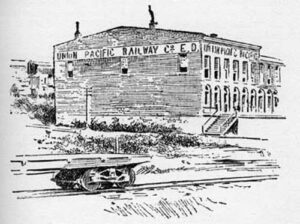
The Wyandotte Constitution meetings were held in the Union Pacific Railway building in Kansas City, Kansas.
The Wyandotte Constitution, 1859. In the summer of the following year, 1859, a fourth constitutional convention was held at Wyandotte (Kansas City.) There was less hard feeling now between the two factions, and the members of this convention were from both political parties, Democrat and Republican. It was generally conceded by this time that Kansas was to be a free state, and the new Constitution contained the words, “There shall be no slavery in this State; and no involuntary servitude, except for crime, whereof the party shall have been duly convicted.” This was called the Wyandotte Constitution, and when it was submitted to the people in the fall, a large majority of the votes were cast in favor of it.
Kansas Admitted to the Union, January 29, 1861. But the question was not yet settled, for Congress had to vote on the admission of Kansas under the Wyandotte Constitution. These events occurred in the closing days of 1859, only a little more than a year before the beginning of the Civil War. Relations between the North and the South had strained almost to the breaking point. The Congressmen from the South had given up hope of making Kansas a slave state, but they were certainly not anxious to admit it as a free state.
Consequently, a year passed before the Wyandotte Constitution of Kansas was acted upon. Finally, in January 1861, some southern states seceded from the Union, and their representatives and senators withdrew from Congress, leaving a Free-State majority. The bill for the admission of Kansas under the Wyandotte Constitution was at once called up and passed. The next day, President James Buchanan signed it, and Kansas became a state on January 29, 1861.
First State Officers. In December 1859, shortly after the people had voted to adopt the Wyandotte Constitution, they held an election to choose state officers to act whenever Kansas should be admitted to the Union. For Governor, they chose Dr. Charles Robinson, who faithfully served the Free-State cause throughout the long but successful struggle. The first United States senators from Kansas were two well-known Free-State men, James H. Lane and Samuel C. Pomeroy. The Wyandotte Constitution designated Topeka as the temporary capital. An election was held in November 1861 to select a permanent capital. Topeka received 7,996 votes, Lawrence 5,291, and all other places 1184. Thus Topeka became the capital of Kansas.
Summary. The first two and a half years of the Territorial period were spent in warfare, which was practically closed when Governor Geary sent “the 2700” home. The last four months of the two-and-a-half years formed the “period of violence.” The next three years were given to the political struggle, which ended with the adoption of the Wyandotte Constitution. During the remaining year, the people did their work while this Constitution was pending in Congress. In 1857, early in the political period, the Free-State people succeeded, for the first time, in electing the Legislature. The pro-slavery people prepared the Lecompton Constitution but submitted only two statements concerning it to the people. The Free-State people refused to vote but held another election, at which the pro-slavery people refused to vote. After the Lecompton Constitution was returned from Congress, it was voted on by both factions and defeated. In the meantime, the free-state people submitted the Leavenworth Constitution, which was defeated. During the last six months of the political period, the Wyandotte Constitution was prepared, adopted, and sent to Congress. This was in 1859. More than a year passed before Congress acted on the matter; then, on January 29, 1861, Kansas became a state.
Compiled & edited by Kathy Alexander/Legends of America, updated January 2023. Source: Arnold, Anna E.; The State of Kansas; Imri Zumwalt, state printer, Topeka, Kansas, 1919.
Also See:
Bleeding Kansas & the Missouri Border War


